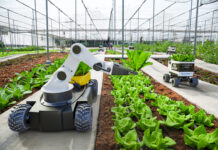
The pursuit of precision and quality is more critical than ever in the rapidly evolving manufacturing landscape. Manufacturers across industries are constantly seeking innovative solutions to improve their processes, reduce errors, and increase productivity. One such breakthrough technology that has revolutionized manufacturing is robotic vision systems. These systems combine the power of robotics and advanced visual perception to enhance precision and quality in manufacturing processes.
The Rise of Robotic Vision Systems
Robotic vision systems, often referred to as machine vision or computer vision, are a subset of artificial intelligence (AI) technology. These systems equip robots with the ability to see, interpret, and react to visual data, similar to how humans use their eyes to understand the world. Over the years, robotic vision systems have seen significant advancements, thanks to improvements in hardware and software capabilities.
These systems consist of a combination of hardware components like cameras, sensors, and lighting, alongside sophisticated software that can analyze and make decisions based on the visual data collected. The synergy of these components allows robots to perform tasks that require a high degree of precision and quality control, such as inspecting products for defects, assembling intricate components, and even navigating complex environments.
Enhancing Precision in Manufacturing
Robotic vision systems have played a pivotal role in enhancing precision in manufacturing. They offer several advantages:
Accurate Inspections
One of the most common applications of robotic vision systems is quality control and inspection. These systems can meticulously examine products for defects, ensuring that only high-quality items reach consumers. The precision and consistency of robotic vision far surpass what human operators can achieve, leading to fewer false positives and a decrease in defective products.
Assembly and Pick-and-Place
In industries where precision assembly is critical, such as electronics and automotive manufacturing, robotic vision systems enable robots to precisely position and connect components. This not only enhances product quality but also increases the speed of assembly processes.
Customization
Manufacturers can use robotic vision to create customized products with unique features. The system can identify individual components and adjust the manufacturing process accordingly, making it possible to produce a variety of product variants with minimal human intervention.
Tolerance Monitoring
In applications that require tight tolerances, robotic vision systems can continuously monitor and adjust processes in real-time to maintain precision. This is crucial in industries like aerospace, where even the slightest deviation from specifications can have catastrophic consequences.
Quality Control and Error Reduction: 4 Benefits of Quality Control Automation
In addition to precision, robotic vision systems significantly contribute to maintaining high standards of product quality. They can quickly and accurately identify deviations from predefined quality standards, which is especially important in industries where safety and reliability are paramount.
By automating quality control processes, manufacturers can achieve the following benefits:
- Consistency: Robotic vision systems provide consistent and reliable quality control, reducing the variability associated with manual inspections. This ensures that products meet the same high standards consistently.
- Higher Yields: By identifying defects early in the manufacturing process, companies can reduce waste and rework. This leads to higher yields and cost savings, making manufacturing more efficient and cost-effective.
- Traceability: Many industries require comprehensive traceability records for their products. Robotic vision systems can capture and store data related to each product, including images and inspection results, facilitating traceability and regulatory compliance.
- Reduced Human Error: Human error can be a significant factor in manufacturing defects. Robotic vision systems eliminate this factor, resulting in a reduction in costly errors and product recalls.
Applications Across Industries
Robotic vision systems have made a significant impact on various industries, including but not limited to:
Automotive: Robotic vision is used for inspection and assembly of vehicle components, ensuring that the final product meets high-quality standards.
- Case Study: Ford’s Use of Robotic Vision for Quality Control: Ford implemented robotic vision systems to inspect paint quality on car bodies. These systems can detect even minor imperfections that may not be visible to the human eye. This technology has resulted in a significant reduction in defects and enhanced the overall finish of their vehicles.
Electronics: In electronics manufacturing, these systems are crucial for quality control, precise assembly, and identifying defects in micro-components.
Pharmaceuticals: Robotic vision systems play a vital role in pharmaceutical manufacturing by ensuring the quality and consistency of drugs and medical devices.
- Case Study: Pharmaceutical Packaging Inspection at Pfizer: Pfizer utilizes robotic vision systems to inspect the packaging of pharmaceutical products for defects, ensuring that no compromised packaging reaches consumers. This technology has improved product quality and regulatory compliance.
Food and Beverage: They are used to inspect and sort food products, ensuring safety and adherence to quality standards.
Aerospace: In aerospace, precision and quality are of utmost importance, and robotic vision systems are used in manufacturing, maintenance, and inspection of aircraft components.
Challenges and Future Developments
While robotic vision systems offer significant benefits, they are not without challenges. Implementing and maintaining these systems can be complex and costly. Integration with existing manufacturing processes, training, and addressing potential issues with lighting and environmental conditions are key considerations.
As for the future, we can expect continued advancements in robotic vision technology, including improvements in machine learning and AI algorithms, 3D vision capabilities, and the development of more cost-effective and user-friendly systems. This will make robotic vision more accessible to a broader range of industries, ultimately leading to enhanced precision and quality across the manufacturing sector.
Robotic vision systems are a transformative technology that holds immense potential for enhancing precision and quality in manufacturing. These systems offer unmatched accuracy, consistency, and the ability to conduct repetitive tasks tirelessly. As industries continue to embrace these innovations, we can anticipate a future where manufacturing processes are more efficient, cost-effective, and capable of producing products of the highest quality. Robotic vision systems have not only changed the way we manufacture goods but have also set the stage for a new era of automation and quality control in the manufacturing industry.




